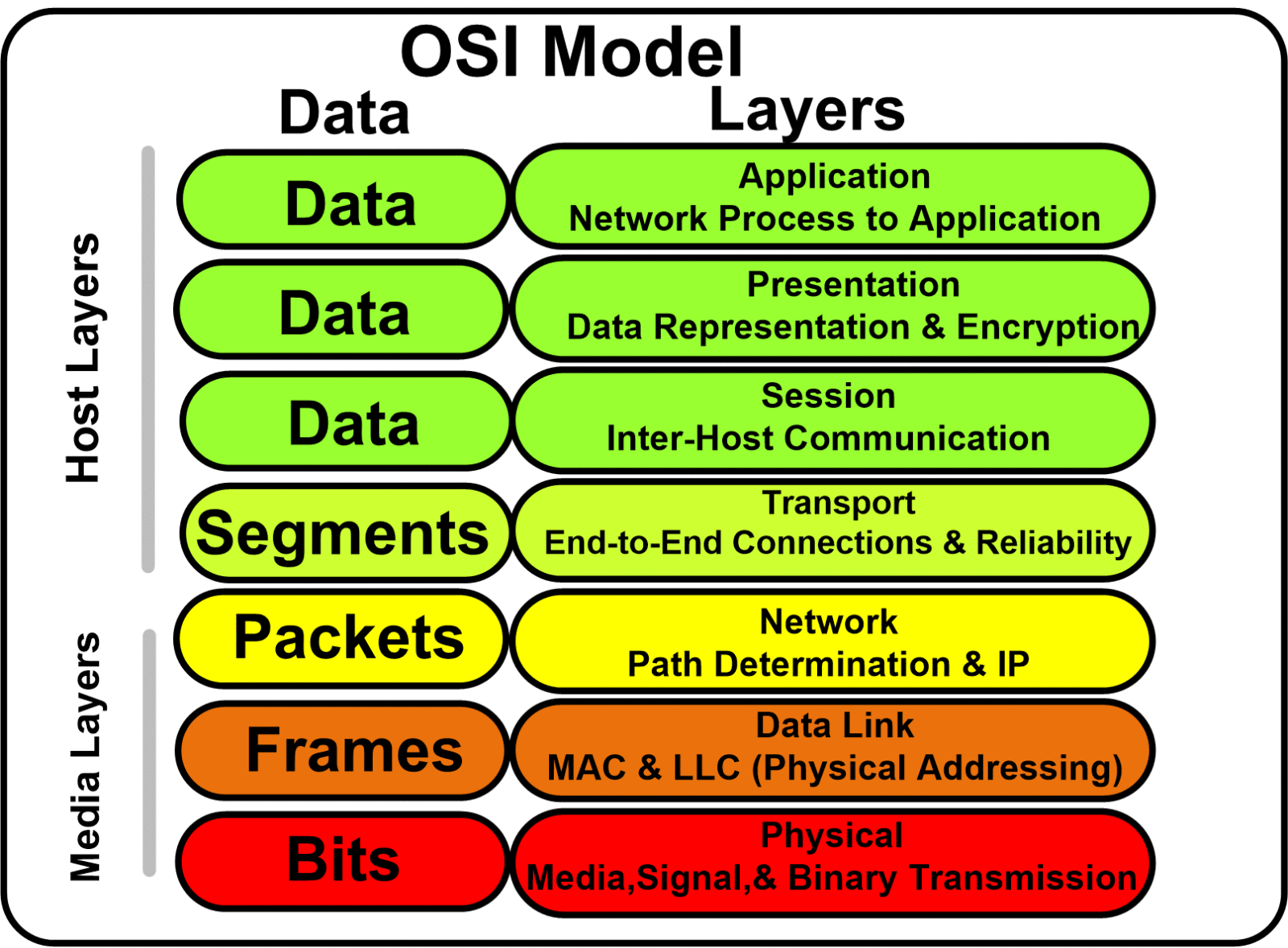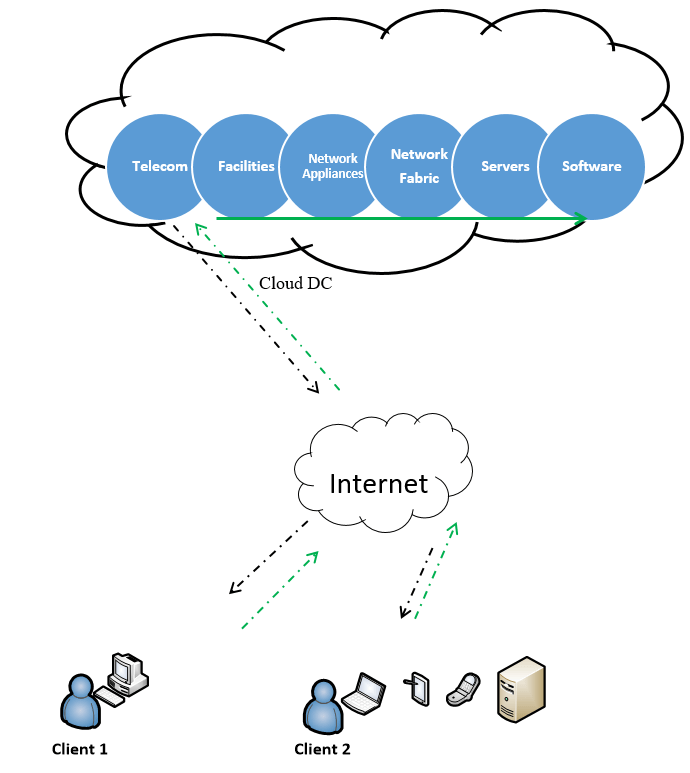OSI Model
The structure of the Internet is modeled on the Open Systems Interconnection (OSI) model. The OSI model is a framework used for all communications in the cloud. The OSI model represents the interfaces and protocols used to communicate between devices. Every network device must adhere to the rules and standards that this model represents, so each device can communicate with the other devices in the network.
A representation of the model is shown in Figure 1. Each layer has a name and a layer number. The application layer at the top is layer 7 and is closest to the end user. The physical layer at the bottom is layer 1 and is closest to the computer.
Figure 1: OSI Model with Seven Layers
Host Layers of OSI Model
Application Layer
A web browser interacts with the application layer of the OSI model using commands supplied by the application layer to communicate. This functionality is called an Application Program Interface (API). An API contains the programming instructions, protocols, and tools used to communicate. APIs specify how software components interact with each other. Another way of looking at this process is, the browser wants to communicate with the website requested, so it formats a command for the application layer using the API and issues the command. The application layer interprets the command, verifies it for syntax, and processes the command.
Presentation Layer
The next step in the OSI model is to process the command and pass it to the presentation layer. Differences in how data is represented are resolved here, including converting EBCDIC data to ASCII data. Encryption and decryption are typically handled in the presentation layer, or it can be done in the application, session, transport, or network layers.
Session Layer
The presentation layer ensures that information from the application layer is readable by the next layer, the session layer. As the request flows through the stack, the session layer sets up the rules needed for the two devices to communicate.
Transport Layer
The transport layer breaks large messages into smaller chunks called segments. The other function of the transport layer is to make sure that all communications are completed successfully by using a notification process based on acknowledgments. The transport layer ensures the successful transmission and reception of the data; this assurance is called reliability.
Media Layers of OSI Model
Network Layer
The network layer of the OSI layer is responsible for path determination. The logical path to the destination is derived from the network address. Network addresses, or logical addresses, are normally IPv4 or IPv6 addresses.
Data Link Layer
Network layer packets are passed to the data link layer where the logical address (IP address) is converted to the Media Access Control (MAC) address of the next device in the path to the destination.
Physical Layer
All of the information, including the data, is placed in the output buffer of the network interface card (NIC) and then transmitted onto the network media. The NIC and network media reside at the physical layer of the OSI model.
OSI Layer Functions
The message propagates over the network media. Every device that can hear the transmission will receive the message in its NIC input buffer at the physical layer of OSI model.
The NIC passes the message to the data link layer. Once at the data link layer, the destination MAC address is evaluated to determine if the message is designated for ‘this’ physical device. If not, the message is ignored. However, if ‘this’ is the correct destination, the message is passed to the network layer.
At the network layer, the IP address is evaluated to determine if ‘this’ is the correct logical destination. If not, this is just a hop on the path to the destination. The IP address is converted into a network address, and the logical path of the next hop is determined from the routing table. The message is passed back down through the stack and transmitted out. This process is repeated until the destination is reached. If ‘this’ is the correct destination, the information is passed through the OSI model to the transport layer where all of the parts of the message are reassembled, and an acknowledgment is sent to the sender, letting the sender know that the message was received. This process is the acknowledgment function of TCP/IP.
The message is passed through the stack, to each succeeding layer until the application needed to resolve the request is reached, and a response is prepared. The response is then passed back through the OSI layers beginning with the application layer.
Cloud Data Centers
A cloud data center (DC) environment consists of several components that comprise its architecture. Common components include clients, one or more web APIs, and the underlying network. The network connects users to the cloud infrastructure and is responsible for interconnectivity within the cloud DC. Figure 2 illustrates about DCs in a cloud environment.
Figure 2: Components of Cloud Computing
A cloud DC is a mix of telecom, facilities, network appliances, network fabric, servers, and software. The Client-side consists of any network-ready device, such as a computer, tablet, or smartphone. The connection between the two is the Internet.
A cloud DC has the following components:
- Telecom is the hardware and services needed to connect to the Internet.
- Facilities represent the building, power, air conditioning, and water needed to house and run the equipment
- Network Appliances include firewalls, routers, switches, SANs, and other associated networking equipment.
- Network Fabric defines all the cables used to interconnect the network equipment and the servers, as well as specialized switches designed for virtualization and storage environments.
- Servers include both physical and virtual servers that are used within the cloud infrastructure.
- Software describes the software needed in order to serve the customers.
APIs contain a set of programming instructions, protocols, and tools for accessing programs. These programs, in turn, provide the services needed to manage the DC. APIs are at the heart of cloud services.
The fabric of a DC is its network. The network provides the path or route needed for the servers, routers, switches, storage arrays, and other components to communicate. Further, the network provides the services requested by the client. It is the same fabric that allows DCs to talk to other DCs, for workload sharing and redundancy in case of disaster.



